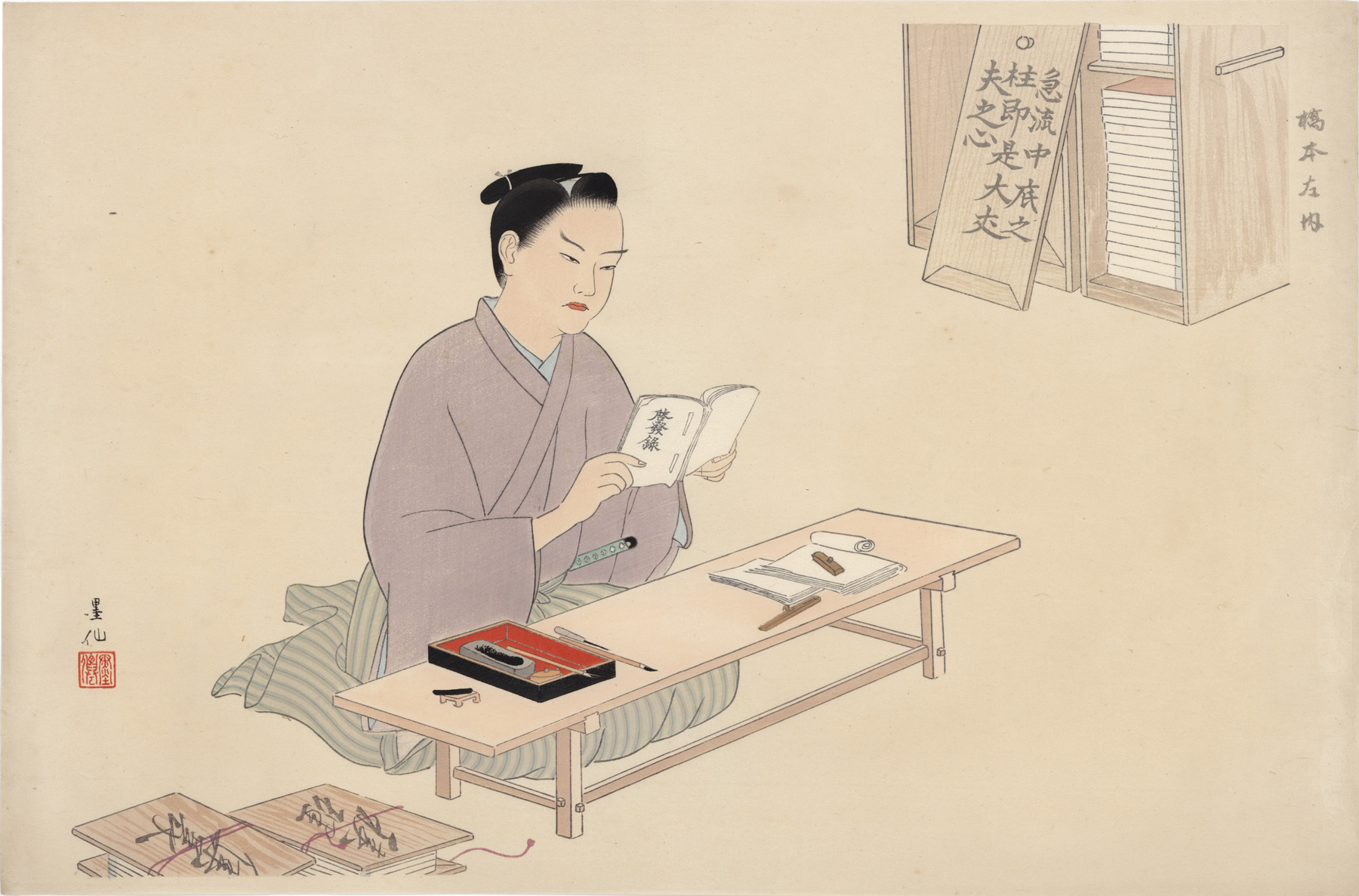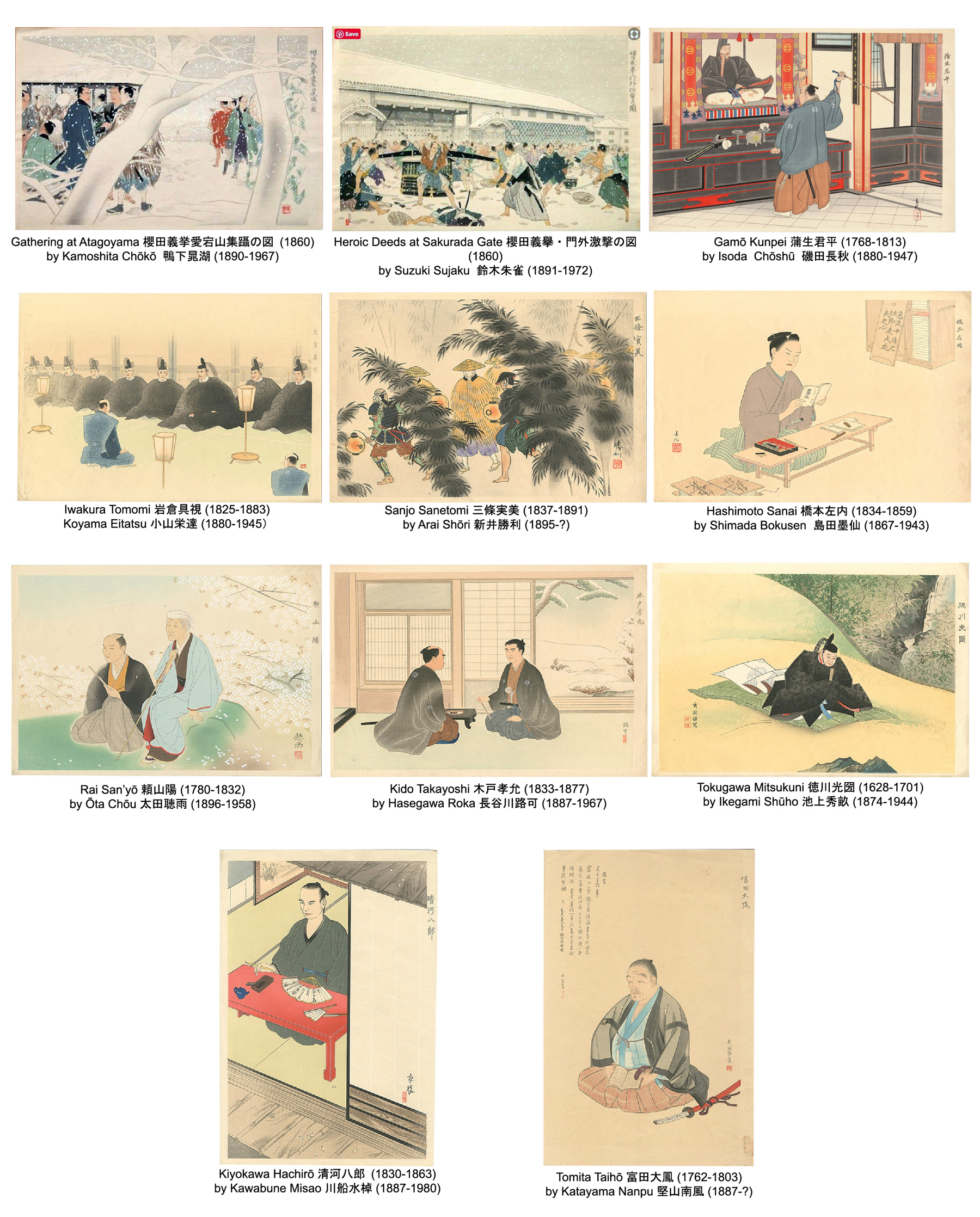About This Print
Shimada depicts the samurai philosopher Hashimoto Sanai shortly before his execution at the age of 25. He sits at his desk re-reading his treatise Keihatsuroku 啓發録 (A Book of Resolutions or Treatise on Enlightenment) which he wrote at the age of 15 in 1848.Hashimoto Sanai橋本左内 (1834-1859), was a samurai born in Echizen in Fukui prefecture who lived in the last days of the Tokugawa shogunate. At the age of 15, in 1848, he went to Osaka to study Western medical science and it is there he wrote his famous Keihatsuroku, a treatise that lays out the correct behavior for young men and boys, a set of resolutions for them, that he himself followed.
Hashimoto was a strong proponent of opening up Japan to the West while keeping Japan's "own ethics and morals."1 While he supported early policies by the Shogun that contributed to opening up Japan, he later turned against the shogunate, supporting efforts to restore the emperor to power. He was executed during the Ansei Purge at the age of 25 in 1858, conducted by the Shogun's Senior Minister, Ii Naosuke, against certain anti-shogunate reformers.
About The Series Thirty Great Loyalists of Early Modern Times 近世勤皇家三十傑
This series of thirty prints titled Thirty Great Loyalists of Early Modern Times depicts figures active in the mid/late Edo through Meiji eras who displayed great loyalty to the Emperor and, thereby, the nation. Issued in 1942 when the war in the Pacific was raging, the patriotic theme of these prints was clear.
 Watanabe "G" type seal embossed on margin of some prints (reproduced "G" type seal on left for clarity)
Watanabe "G" type seal embossed on margin of some prints (reproduced "G" type seal on left for clarity) embossed seal onmargin reading勤皇文化振興會Kinnō bunka shin kōkai [Society for the Promotion of Loyalist Culture]
embossed seal onmargin reading勤皇文化振興會Kinnō bunka shin kōkai [Society for the Promotion of Loyalist Culture]The series was conceived under the direction of the patriotic organization Kinnō bunka shinkōkai (Society for the Promotion of Loyalist Culture), about which little is known.2 For some of the prints in the series, the Society collaborated with the publishing business of Watanabe Shōzaburō, as Watanabe's "G" type seal is embossed in the margin, in addition to the embossed seal of the Society, both shown to the left. From the series' name we can assume that thirty prints were planned, although I could only locate eleven prints through a web search, which are pictured below.
All of the artists for the eleven prints were nihonga (Japanese-style) painters and their involvement might either indicate their patriotism or just a desire to stay in the good graces of the authorities during a time when artistic freedom was being greatly curtailed and artistic output directed to serve the war effort. While painting, particularly realistic looking Western painting in large formats, was the cutting edge of war art, prints served as the soft-propaganda media, focusing on building patriotism and support for the war effort on the home front. For a further explanation of the role of woodblock prints in the war effort see Prints During the War Years 1937-1945, the Occupation (and beyond).
  Watanabe "G" type seal embossed on margin of some prints (reproduced "G" type seal on left for clarity) |  embossed seal on margin reading 勤皇文化振興會 Kinnō bunka shin kōkai [Society for the Promotion of Loyalist Culture] | The series was conceived under the direction of the patriotic organization Kinnō bunka shinkōkai (Society for the Promotion of Loyalist Culture), about which little is known.2 For some of the prints in the series, the Society collaborated with the publishing business of Watanabe Shōzaburō, as Watanabe's "G" type seal is embossed in the margin, in addition to the embossed seal of the Society, both shown to the left. From the series' name we can assume that thirty prints were planned, although I could only locate eleven prints through a web search, which are pictured below. All of the artists for the eleven prints were nihonga (Japanese-style) painters and their involvement might either indicate their patriotism or just a desire to stay in the good graces of the authorities during a time when artistic freedom was being greatly curtailed and artistic output directed to serve the war effort. While painting, particularly realistic looking Western painting in large formats, was the cutting edge of war art, prints served as the soft-propaganda media, focusing on building patriotism and support for the war effort on the home front. For a further explanation of the role of woodblock prints in the war effort see Prints During the War Years 1937-1945, the Occupation (and beyond). |
1 Hashimoto's full statement reads "We will take the machines and techniques from them but we have our own ethics and moral." [Source: Military Intervention in Pre-War Japanese Politics Admiral Kato Kanji and the 'Washington System', Ian Gow, Routledge, 2005, p. 27.
2 The Society published a book in 1941 with the title 勤皇文化振興会 : 性質と事業 and the website of the Meiji Jingu Shrine in their chronology notes that in 1971 the received some works (possibly calligraphic works) collected by the Society. [source: https://www.rekishidb.meijijingu.or.jp/chronology/era_detail.php?year=1971&month=5]
Print Details
IHL Catalog #1968 Title Hashimoto Sanai 橋本左内 Series Thirty Great Loyalists of Early Modern Times 近世勤皇家三十傑 Artist Shimada Bokusen (1867–1943) Signature Seal 墨僊 Bokusen (see above) Publication Date 1942 Edition Publisher
勤皇文化振興會 Kinnō bunka shin kōkai [Society for the Promotion of Loyalist Culture]ナガヤ作 [nagaya saku] 東々五八八 [toto? 588]note: The significance of this oval seal beneath the Kinnō bunka shin kōkai seal which appears on several of prints in this series is unknown. It might be a publisher's seal, as this print does not carry the Watanabe seal as do other prints in the series.Carver unknown Printer unknown Impression excellent Colors excellent Condition excellent Genre Miscellaneous Format oban H x W Paper 10 x 15 3/8 in. (25.4 x 39.1 cm) H x W Image 9 1/2 x 14 in. (24.1 x 35.6 cm) Collections This Print Reference Literature
last update:
4/1/2019 created






